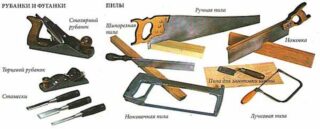The process of processing wood, steel parts is faster on a workbench. The multifunction table increases productivity, makes work safe and comfortable. Craftsmen assemble a workbench in the garage with their own hands in order to provide for the necessary holes in the tabletop, it is convenient to place clamps, stops. You can simplify the installation as your situation requires.
- Device and varieties
- What is a workbench in a garage for?
- Garage workbench requirements
- Design features
- Dimensions and drawings of workbenches
- Material selection
- Choosing between wood and metal
- Tools and materials for the manufacture of structures
- How to make a workbench with your own hands
- Basic configuration
- Assembly stages
- Place of installation
- Final work
Device and varieties
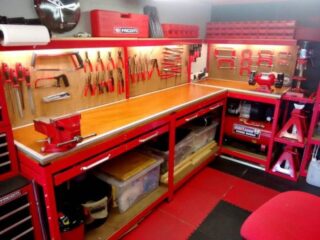
The design is a working table with installed vices, fasteners, and other devices. Tables are completed with tare containers, bedside tables for storage of hardware, tools.
There are three types of workbenches:
- locksmith;
- carpentry;
- universal.
The first type is designed to work with iron parts. It is made in the form of a steel frame with a cover (5 - 6 mm), framed by bumpers on three sides. A metal sheet (1 - 1.5 mm) is welded onto the lid.
At the carpentry workbench, they work with wooden parts and lumber. The constructions are long (4 - 6 m). At the base there are 2 posts with a cross member. The table top is made of solid dry wood.
The universal look combines the qualities of a locksmith's and a joiner's tables, for example, a metal lid on a wooden pedestal, while the workbench has large dimensions in length and is adjustable in height.
What is a workbench in a garage for?
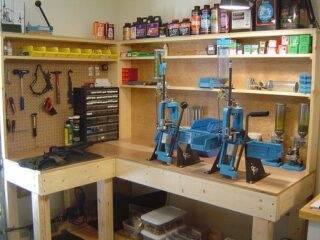
The working parameters of the table depend on the degree of equipment. In the garage workshop, workbenches are assembled, which solve many problems. The workbench is just a surface, and its performance depends on the toolbox. The obligatory one is a vice.
A workbench in the workshop garage room is needed for such work:
- marking of elements, cutting and bending of wood and iron parts;
- carving, precise cutting, engraving;
- lapping of edges, finishing by grinding, riveting, polishing processes.
Operations are performed during vehicle and engine inspection to maintain the car in working order. Small locksmith procedures will be required for minor repairs of tools, devices needed to maintain a personal plot and a house.
The owner can make carpentry and plumbing his hobby, then it is difficult to do without the use of a garage workbench. It is convenient to place tools near the surface for processing.
Garage workbench requirements
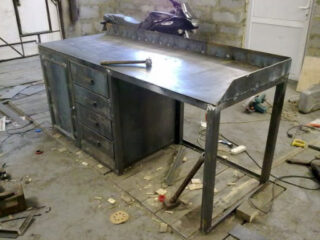
The structure is made strong and reliable, it must resist shock, bending and shear forces. A stable frame, together with a work plane, corresponds to the growth of the master, has boxes for storing small items. A high-quality construction will last 1.5 - 2 decades without losing its original characteristics.
The frame is made of durable iron, which is complemented by a powerful lid. Sheet metal is used, double MDF panels with a thickness of 3 cm, the top is covered with a steel sheet. Such a table will withstand impacts, while retaining the possibility of accurate processing.
The galvanized coating tolerates interaction with oils, solvents, gasoline, and other aggressive components without any problems, it is easy to clean. For reliability, it is coated with durable powder paint. The sides on three sides do not allow small parts to fall, sometimes a removable screen is installed to protect it from dust and metal shavings.
Design features
Stationary devices have storage tanks, while folding and mobile devices are equipped only with a lid, on which devices can be mounted later. Vices are usually placed in front and on the sides, they are purchased ready-made. You can make the device yourself by taking the clamp and the screw mounted in the board for adjustment.
The cover provides holes for the installation of stops, devices along the length of the structure. The bed consists of legs in the form of legs, which are reinforced with a transverse element and struts. Stability depends on the number of additional struts. The width of the supporting part is always less than the width of the table top, so that it is more comfortable to work.
Some people prefer to do the work while sitting. In this case, the longitudinal run of the frame should not interfere with the knees of a person. When working while standing, there should be no obstacles to movement along the table.
Dimensions and drawings of workbenches
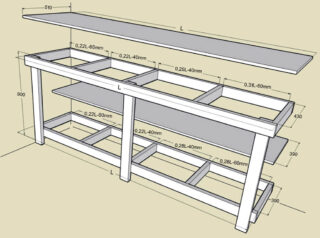
If the height dimensions are made without taking into account the height, supports for the legs of 40 cm are needed. The height of the seat is measured from the bottom of the shod foot to the center of the notch under the knee. For an average height, 45 - 47 cm are taken as standard.
Dimensional parameters of a workbench in a garage with your own hands made of wood:
- the thickness of the table starts from 50 - 60 mm, the strength of the surface proportionally depends on this;
- the standard width is 60 mm;
- length - 120 cm.
Before work, draw up a drawing. Single-pillar designs have a storage unit in the form of a pedestal with mobile boxes on ball runners at different heights. Sometimes they make adjustable shelves and add a toolbar.
Two-pillars as part of the structure provide for two bedside tables with drawers of different heights. On the rear vertical plane, a perforated panel is mounted for placing tools.
Material selection
The material is wood, steel, or a combined version is made. In a composite version, the support frame is made of hard rocks. To do this, take oak, birch, sycamore, maple, acacia, apple tree. It is not recommended to take spruce, fir, aspen, linden, chestnut.
Wooden posts and longitudinal elements can be fastened with iron corners or shaped pipes for stability and reliability. There are single spacers or x-shaped structures. For fixing, screws and bolts are used. The iron walls of the bedside tables are equipped with drawers with sides, shelves are made of thick OSB panels.
Compliance with the assembly technology contributes to an increase in the service life, despite the materials chosen for the manufacture of the desktop.
Choosing between wood and metal
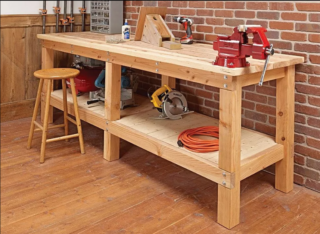
Wooden workbenches are often made with two bollards. Two storage compartments serve as supports for the connecting table top.
This manufacturing option is cheap, but has some disadvantages:
- no great effort should be made;
- significant loads shorten the service life.
Wood requires preliminary and regular treatment with antiseptics, moisture impregnation. The surface gradually deteriorates from aggressive components, for example, automobile oil, gasoline drops.
Steel workbenches allow you to perform various jobs, they can withstand heavy loads. Strength is provided by metal supports, beams, frame struts. The worktop with a metal or galvanized coating does not deform from aggressive substances. Wood and iron dust is quickly removed from the coating.
Tools and materials for the manufacture of structures
You will need tools:
- grinder with a cutting disc and a grinding wheel;
- welding with a set of consumables;
- measuring tool, level, carpentry square;
- core for metal, pencil;
- screwdriver, electric drill.
A thick layer of sheet is prepared for the countertop, if necessary, it is welded in two layers. For the manufacture of boxes, take plywood with a thickness of 8 mm. Self-tapping screws 50 mm long are prepared to fix the wooden parts together. Final processing will require a primer for metal, paints and varnishes, and a solvent.
How to make a workbench with your own hands
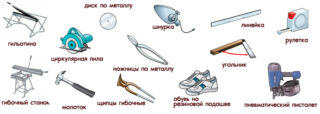
A certain number of parts are prepared for a standard table. Vertical racks are cut in two sizes: 90 and 150 cm. The difference arises from the need to equip a screen for storing tools, which is higher than the racks-legs.
Prepare details:
- leg racks - 4 pcs.;
- transverse supports - 5 pcs. 60 cm each;
- horizontal purlins - 2 pcs. 2 m each for the top of the frame;
- connecting beams - 2 pcs. 60 cm for the bottom.
Horizontal elements connect the support posts at the top and serve as a base under the table top. At the bottom, the legs are connected with beams on both sides, spacers are attached. Steel elements are joined by welding; bolted connection with nuts can be used. For the toolbox, thick plywood is taken, into the body of which hooks are inserted for hanging, removable and stationary containers are attached to the surface.
The workbench is connected to a common ground loop. The upper shelves and the backboard with fixtures are firmly fixed to the walls and floor. Metal anchors are used, and screws and self-tapping screws will not withstand the effort. The electrician is hidden in PVC wired channels or corrugated special hoses. Lighting is done from above and from the left side.
Basic configuration
The metal frame (frame) is a loadable structure that can withstand a weight of up to 350 kg, depending on the structure and configuration. The workbench includes various modules and reinforcement parts. Tables for servicing large car parts, for example, units or wheels, are reinforced with an additional pair of diagonals.
The table top is made according to the type of work. Depending on this, the material of the slab and the type of coating on the working plane are selected. A vise is installed to fix workpieces and parts during locksmithing and assembly. Take into account the size of the jaws, the depth of grip and the working range, take into account the dimensions of the device and its weight. There are stationary and rotary vices.
Assembly stages
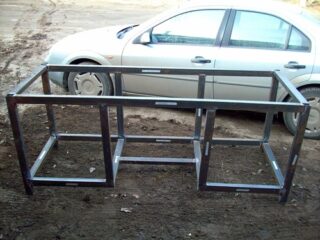
Initially, the frame is welded. For this, a base platform is made under the countertop.
A phased scheme for assembling and arranging a garage workbench:
- The support platform is turned over, the frame of the bedside table and the legs of the legs are welded to it. All supports are connected by struts, longitudinal and diagonal (rear) reinforcements.
- To level and clean the seams, use a grinder, remove burrs at the edges, smooth out sharp edges from cutting iron.
- The workbench is turned over to its usual position, and fixed in the chosen place. The table top is made of wood or metal. The boards are bolted to the support and the steel cover is welded.
- The back wall is installed and fixed, the inner filling of the side cabinets and racks is arranged.
Basic activities are listed, but additional processes may be added depending on the design.
Place of installation
The choice of location is determined by the size of the workbench. If you need to do certain work from time to time, a small table will do, it will be more convenient for it to choose a place.The need for constant work leads to an increase in size, for this a significant area in the garage space is allocated.
Criteria for choosing a workplace:
- a sufficient amount of free space to keep even a folding workbench in a ready-to-work position, and not to remove it after the end of work;
- the structure is placed perpendicular to the light source or window opening;
- it is possible to pull the iron safety net when grinding, milling, turning;
- on the front side of the table there is a strip 50 cm wide and more for free movement of a person during work.
When choosing, take into account that a connection to an electricity source is required.
Final work
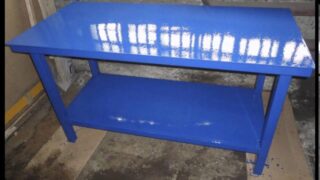
Finishing consists of priming on metal or wood, in the case of wooden parts. The primer dries completely, after which the surface of the structure is covered with oil, enamel, latex paint. It is recommended to apply 2 coats.
Painting protects the metal surface from corrosion, rust, and the wood will not absorb moisture. You can varnish the workbench on top.

